
Sikai Wang
Plotting mechanics and EDA
Run the code below, and read along.
In the last assignment, I gave you a list of firms from 2020 with variables
- “gvkey”, “lpermno”, “lpermno” = different datasets use different identifiers for firms
- “fyear” = the fiscal year the remaining variable apply to
- “gsector” = gsector, an industry classification (see the wiki article on GICS)
- “state” = of headquarters
- “tic” = ticker
- various accounting statistics
This data is a small slice of Compustat, which is a professional grade dataset that contains accounting data from SEC filings.
We downloaded it and found a subsample of firms that we were interested in:
import pandas as pd
import numpy as np
import seaborn as sns
import pandas_datareader as pdr # to install: !pip install pandas_datareader
from datetime import datetime
import matplotlib.pyplot as plt
import yfinance as yf
plt.rcParams['patch.edgecolor'] = 'none'
# this file can be found here: https://github.com/LeDataSciFi/ledatascifi-2021/tree/main/data
# if you click on the file, then click "raw", you'll be at the url below,
# which contains the raw data. pandas can download/load it without saving it locally!
url = 'https://github.com/LeDataSciFi/data/raw/main/Firm%20Year%20Datasets%20(Compustat)/firms2020.csv'
firms_df = pd.read_csv(url).drop_duplicates('tic')
# add leverage
firms_df['leverage'] = (firms_df['dlc']+firms_df['dltt'])/firms_df['at']
# high_lev = 1 if firm is above the median lev in its industry
firms_df['ind_med_lev'] = firms_df.groupby('gsector')['leverage'].transform('median')
firms_df.eval('high_leverage = leverage > ind_med_lev',inplace=True)
# problem: if lev is missing, the boolean above is false, so
# high_lev = false... even if we don't know leverage!
# let's set those to missing (nan)
mask = (firms_df["leverage"].isnull()) | (firms_df["ind_med_lev"].isnull())
firms_df.loc[mask,"high_leverage"] = None
# reduce to subsample: (has leverage value and in our sectors)
subsample = firms_df.query('gsector in [45,20] & (high_leverage == 1 | high_leverage == 0)')
ticker_list = subsample['tic'].to_list()
Now,
- I will download their daily stock returns,
- Compute (EW) portfolio returns,
- Using (2), compute weekly total returns (cumulate the daily returns within each week).
- Note: These are not buy-and-hold-returns, but rather daily rebalancing!
- If you want buy-and-hold returns, you’d compute the weekly firm level returns, then average those compute the portfolio returns.
##################################################################
# get daily firm stock returns
##################################################################
# I called this first df "stock_prices" in the last assignment
firm_rets = (yf.download(ticker_list,
start=datetime(2020, 2, 2),
end=datetime(2020, 4, 30),
show_errors=False)
.filter(like='Adj Close') # reduce to just columns with this in the name
.droplevel(0,axis=1) # removes the level of the col vars that said "Adj Close", leaves symbols
# reshape the data tall (3 vars: firm, date, price, return)
.stack().swaplevel().sort_index().reset_index(name='Adj Close')
.rename(columns={'level_0':'Firm'})
# create ret vars and merge in firm-level info
.assign(ret = lambda x: x.groupby('Firm')['Adj Close'].pct_change())
.merge(subsample[['tic','gsector','high_leverage']],
left_on='Firm',
right_on='tic')
)
##################################################################
# get daily portfolio returns
##################################################################
# these portfolio returns are EQUALLY weighted each day (the .mean())
# this is as if you bought all the firms in equal dollars at the beginning
# of the day, which means "daily rebalancing" --> each day you rebalance
# your portfolio so that it's equally weighted at the start of the day
daily_port_ret = (firm_rets
# for each portfolio and for each day
.groupby(['high_leverage','gsector','Date'])
['ret'].mean() # avg the return for that day for the firms in the port
.reset_index() # you can work with high_leverage/sector/date as index or vars
# I decided to convert them to variables and sort
.sort_values(['high_leverage','gsector','Date'])
)
##################################################################
# get weekly portfolio returns
##################################################################
# we will cumulate the daily portfolio returns so now we have a
# dataframe that contains weekly returns for a few different portfolios
weekly_port_ret = (daily_port_ret
# compute gross returns for each asset (and get the week var)
.assign(R = 1+daily_port_ret['ret'],
week = daily_port_ret['Date'].dt.isocalendar().week.astype("int64"))
# sidenote: dt.isocalander creates a variable with type "UInt32"
# this doesn't play great with sns, so I turned it into an integer ("int64")
# for each portfolio and week...
.groupby(['high_leverage','gsector','week'])
# cumulate the returns
['R'].prod()
# subtract one
-1
).to_frame()
# this last line above (to_frame) isn't strictly necessary, but
# the plotting functions play nicer with frames than series objs
[*********************100%***********************] 388 of 388 completed
Our first plot
We can plot the weekly potfolio returns easily.
ax = weekly_port_ret.squeeze().unstack().T.plot()
# can access customization via matplotliab methods on ax
plt.show()
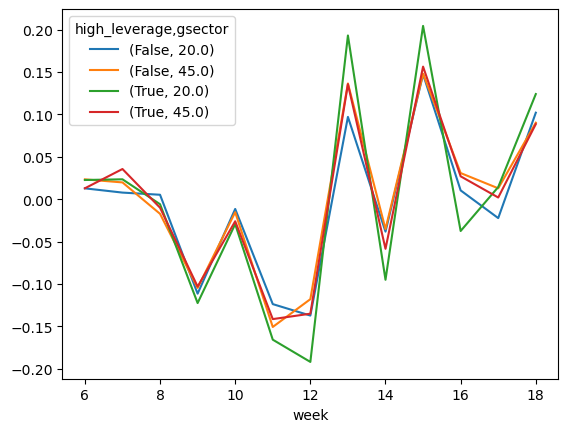
Doing this in seaborn is easy too.
ax = sns.lineplot(data = weekly_port_ret,
x='week',y='R',hue='high_leverage',style='gsector')
# can access customization via matplotlib methods on ax
plt.show()
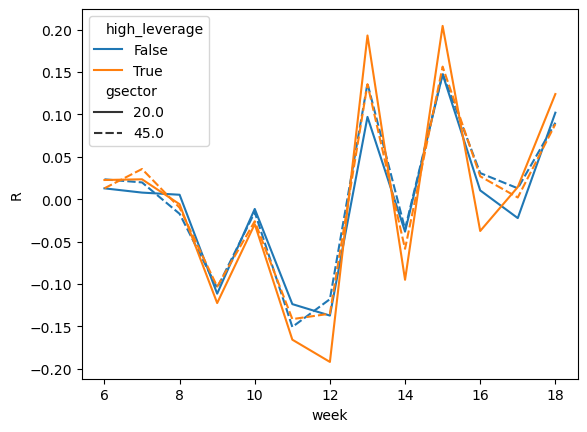
Part 1 - Plot formatting
Insert cell(s) below this one as needed to finish this Part.
Improve the plot above.
- Q1: set the title to “Weekly Portfolio Returns - Daily Rebalancing”
- Q2: set the x-axis title to “Week in 2020”
- Q3: set the y-axis title to “Weekly Return”
- Q4: Ungraded bonus challenge: change the legend so it says the industry names, not the numbers
ax = sns.lineplot(data = weekly_port_ret,
x='week',y='R',hue='high_leverage',style='gsector')
# Q1
plt.title("Weekly Portfolio Returns - Daily Rebalancing")
# Q2
plt.xlabel("Week in 2020")
# Q3
plt.ylabel("Weekly Return")
# Q4
plt.show()

Part 2 - Replicate/Imitate
Insert cell(s) below each bullet point and create as close a match as you can. This includes titles, axis numbering, everything you see.
- Q5: Replicate F1.png. Notice the x-axis has no label - it’s in the title.
Q5_plot=sns.displot(data=weekly_port_ret,x='R',kde=True)
Q5_plot.set(xlabel=None)
plt.title('Weekly Portfolio Returns')
plt.show()
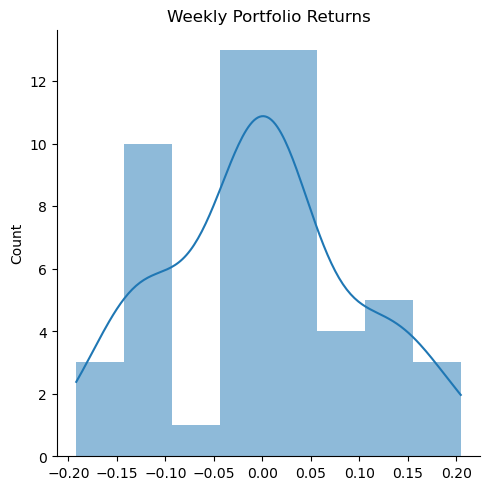

- Q6: Replicate F2.png. Notice the bin sizes are 5%.
Q6_plot=sns.displot(data=weekly_port_ret,x='R',bins=np.arange(-0.4, 0.4, 0.05))
Q6_plot.set(xlabel=None)
plt.title('Weekly Portfolio Returns')
plt.show()
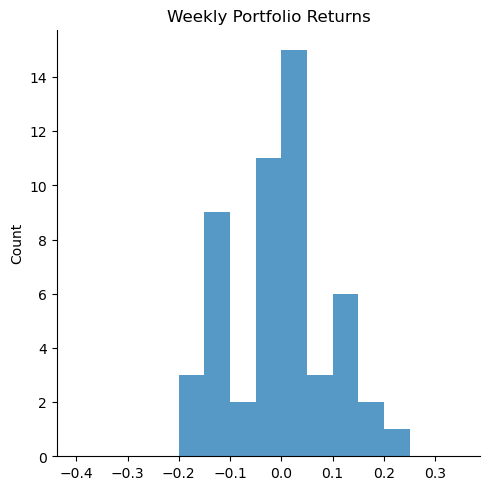

- Q7: Replicate F3.png. Pay attention to the header for a clue!
plt.figure(figsize=(5, 7))
sns.boxplot(y='ret', data=firm_rets, color='steelblue')
plt.title('Firm Daily Return')
plt.show()
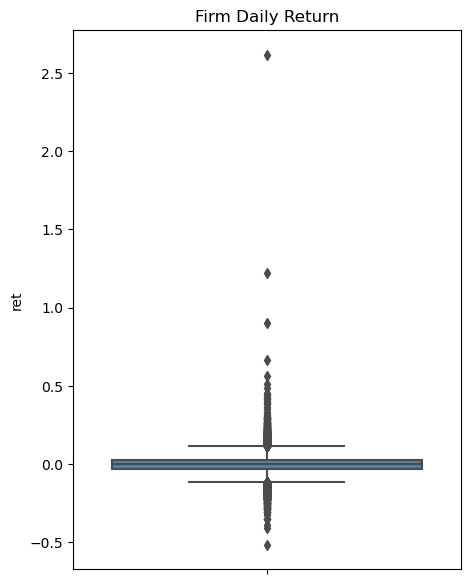

- Q8: Replicate F4.png. Pay attention to the header for a clue!
plt.figure(figsize=(5, 6))
sns.boxplot(x='high_leverage', y='ret', data=firm_rets)
plt.title('Firm Daily Return')
plt.show()
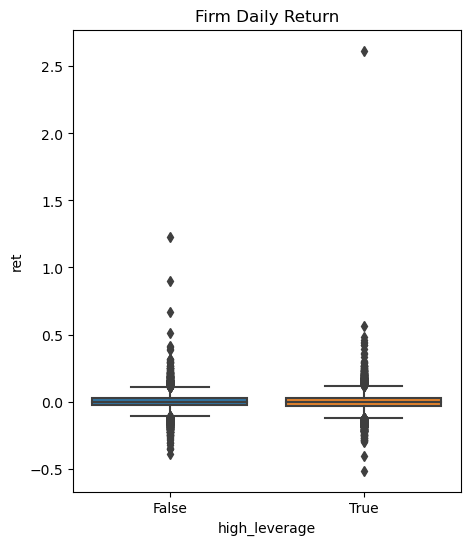

- Q9: Replicate this figure, using this
totaldataset:
total = pd.DataFrame() # open an empty dataframe
total['ret'] = (firm_rets.assign(ret=firm_rets['ret']+1) # now we have R(t) for each observation
.groupby('tic')['ret'] # for each firm,
.prod() # multiple all the gross returns
-1 # and subtract one to get back to the total period return
)
total['cnt'] = firm_rets.groupby('tic')['ret'].count()
total['std'] = firm_rets.groupby('tic')['ret'].std()*np.sqrt(total['cnt'])
total = total.merge(firm_rets.groupby('tic')[['high_leverage','gsector']].first(),
left_index=True, right_index=True)
total = pd.DataFrame() # open an empty dataframe
total['ret'] = (firm_rets.assign(ret=firm_rets['ret']+1) # now we have R(t) for each observation
.groupby('tic')['ret'] # for each firm,
.prod() # multiple all the gross returns
-1 # and subtract one to get back to the total period return
)
total['cnt'] = firm_rets.groupby('tic')['ret'].count()
total['std'] = firm_rets.groupby('tic')['ret'].std()*np.sqrt(total['cnt'])
total = total.merge(firm_rets.groupby('tic')[['high_leverage','gsector']].first(),
left_index=True, right_index=True)
total
| ret | cnt | std | high_leverage | gsector | |
|---|---|---|---|---|---|
| tic | |||||
| AAPL | -0.065597 | 60 | 0.348535 | True | 45.0 |
| ABM | -0.064676 | 60 | 0.426696 | False | 20.0 |
| ACLS | 0.048741 | 60 | 0.557596 | False | 45.0 |
| ACM | -0.225210 | 60 | 0.438323 | False | 20.0 |
| ACN | -0.093329 | 60 | 0.347341 | False | 45.0 |
| ... | ... | ... | ... | ... | ... |
| XRX | -0.468449 | 60 | 0.473751 | True | 45.0 |
| XYL | -0.111853 | 60 | 0.371912 | True | 20.0 |
| YELL | -0.254464 | 60 | 0.671546 | True | 20.0 |
| ZBRA | 0.009977 | 60 | 0.388039 | True | 45.0 |
| ZS | 0.172650 | 60 | 0.383923 | True | 45.0 |
342 rows × 5 columns
sns.scatterplot( x="std", y="ret", data=total, hue='high_leverage',style = 'gsector')
plt.legend(loc='upper right')
plt.title("Risk and Return (Feb, Mar, Apr 2020)")
plt.xlabel("STD of Return")
plt.ylabel("Return")
plt.show()
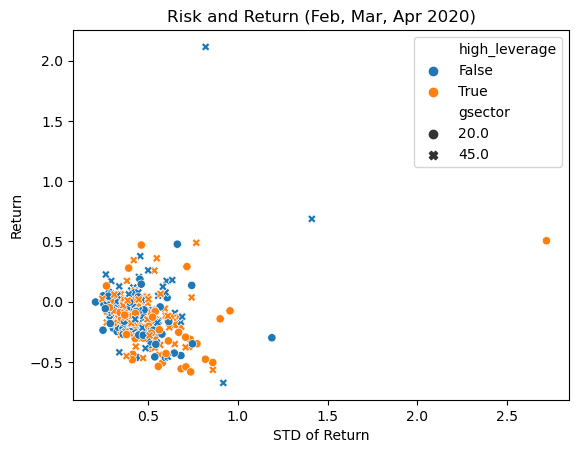

Q10: Choose your adventure. Some ideas:
- Use a pairplot, jointplot, or heatmap on any data already loaded on this page (including the original
firms_df). - Convert any of the stock price datasets to a “wide” format and then use the pair_hex_bin code from the communiy codebook.
- Do something fun with the parameters of the function you choose.
- Or adapt this to improve our portfolio returns plot from Part 1, because Part 1 created a tough to interpret “spaghetti” plot!
- Plot the cumulative returns over the sample period for the four portfolios’ weekly returns from Part 1
- Adapt this to improve our weekly portfolio returns plot from Part 1.
Then save the figure as a png file and share it here on the discussion board.
sns.set_theme(style="dark")
# Plot each year's time series in its own facet
g = sns.relplot(
data=weekly_port_ret,
x="week", y="R", col="gsector", hue="high_leverage",
kind="line", palette="crest", linewidth=1, zorder=6,
col_wrap=2, height=3, aspect=1.5, legend=True,
)
# Iterate over each subplot to customize further
for year, ax in g.axes_dict.items():
# Plot every year's time series in the background
sns.lineplot(
data=weekly_port_ret, x="week", y="R", units="high_leverage",
estimator=None, color=".7", linewidth=1, ax=ax,
)
# Tweak the supporting aspects of the plot
g.set_titles("Weekly Portfolio Returns")
g.set_axis_labels("Weeks", "Returns")
g.tight_layout()
